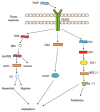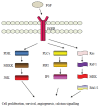Angiogenesis-related pathways in the pathogenesis of ovarian cancer
- PMID: 23903048
- PMCID: PMC3759892
- DOI: 10.3390/ijms140815885
Angiogenesis-related pathways in the pathogenesis of ovarian cancer
Abstract
Ovarian Cancer represents the most fatal type of gynecological malignancies. A number of processes are involved in the pathogenesis of ovarian cancer, especially within the tumor microenvironment. Angiogenesis represents a hallmark phenomenon in cancer, and it is responsible for tumor spread and metastasis in ovarian cancer, among other tumor types, as it leads to new blood vessel formation. In recent years angiogenesis has been given considerable attention in order to identify targets for developing effective anti-tumor therapies. Growth factors have been identified to play key roles in driving angiogenesis and, thus, the formation of new blood vessels that assist in "feeding" cancer. Such molecules include the vascular endothelial growth factor (VEGF), the platelet derived growth factor (PDGF), the fibroblast growth factor (FGF), and the angiopoietin/Tie2 receptor complex. These proteins are key players in complex molecular pathways within the tumor cell and they have been in the spotlight of the development of anti-angiogenic molecules that may act as stand-alone therapeutics, or in concert with standard treatment regimes such as chemotherapy. The pathways involved in angiogenesis and molecules that have been developed in order to combat angiogenesis are described in this paper.
Figures
References
-
- Siegel R., Naishadham D., Jemal A. Cancer Statistics, 2012. CA Cancer J. Clin. 2012;62:10–29. - PubMed
-
- Yabroff K.R., Lamont E.B., Mariotto A., Warren J.L., Topor M., Meekins A., Brown M.L. Cost of care for elderly cancer patients in the United States. J. Natl. Cancer Inst. 2008;100:630–641. - PubMed
-
- Gilks C.B., Prat J. Ovarian carcinoma pathology and genetics: Recent advances. Hum. Pathol. 2009;40:1213–1223. - PubMed
Publication types
MeSH terms
Substances
LinkOut - more resources
Full Text Sources
Other Literature Sources
Medical
Miscellaneous






